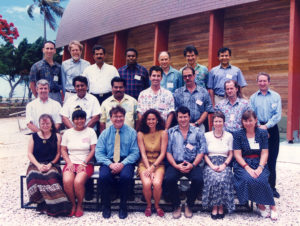Background
The situation in the Pacific Islands before the creation of the PPHSN
All Pacific Island Countries and Territories conducted public health surveillance activities and submitted the data to regional and international agencies such as WHO, UNICEF, SPC, UNDP, UNFPA, and Centers for Disease Control in the USA. Each country or territories had its own system of data collection, processing, and reporting. Several problems had been identified with the surveillance efforts in the Region. The indicators included in the surveillance list were largely determined by the international agencies. While there was limited regional collation of surveillance data, the activity was not integrated to provide a comprehensive perspective of regional needs and priorities. Training programs for quality data collection, their analysis and interpretation at the national level were not always coordinated between aid agencies, and might not address specific regional perspectives.
Furthermore, there was a heavy demand on the countries and territories to provide information on a large number of indicators and the indicators were requested in formats prescribed differently by each of the agencies. The countries and territories conceded that it was difficult to provide quality data with the high level of demands upon them, and that the data were therefore of limited usefulness in local and regional decision-making and action. At the same time, the agencies too were aware of these limitations, and usually tended to publish the data with the appropriate qualifications about the data quality.
To address these problems with surveillance, the Secretariat of the Pacific Community (SPC), WHO and UNICEF sponsored the Inter-agency Meeting on Health Information Requirements in the South Pacific in Noumea, New Caledonia in December 1995. Consult the report

The participants included representatives of the agencies, health professionals from five member countries or territories of the SPC, and experts in disease surveillance. The meeting identified various short term solutions to reduce the demands for data provision by the countries and territories. More importantly, it set out a strategic plan for improving surveillance activities so that it would be possible to generate quality data for decision-making and action at the national and regional levels. This included a plan to develop a public health surveillance network in the region. The Pacific Public Health Surveillance Working Group was constituted to develop and implement the recommendations of the meeting.
The Working Group was given its mandate by member nations of the SPC through the Fifteenth Regional Conference of Heads of Health Services in Noumea, New Caledonia in March 1996.
The activities of the Working Group culminated in the “Pacific Island Meeting on Public Health Surveillance” that was co-sponsored by SPC and WHO in Noumea in December 1996, and the Pacific Public Health Surveillance Network was formally established. The meeting was facilitated by members of the regional Working Group, with representatives invited from all PICTs and from a range of institutional and other partners in public health surveillance.
Then the working group turned into its Coordinating Body.
